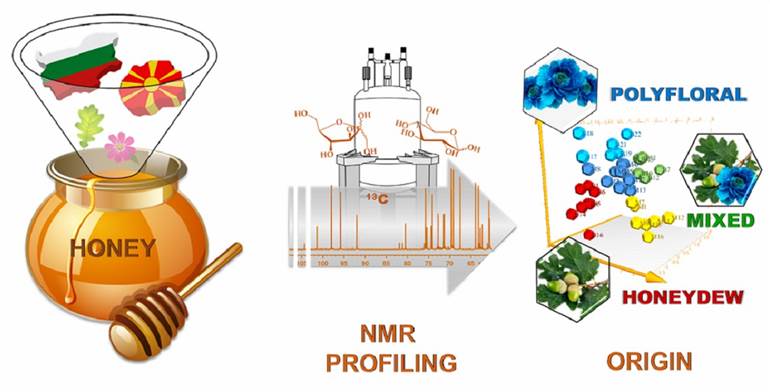NMR-based Honey Analysis
The source and authenticity of food are receiving more and more attention, and consumers are asking for more information about the origin of their honey. As a high-value product used in food, medicine and cosmetics, honey is particularly vulnerable to adulteration. Honey fraud has devastating economic consequences for beekeepers who produce authentic honey, because it has led to a decline in the global price of raw honey, while the production cost has increased significantly. NMR (nuclear magnetic resonance) test is an advanced and comprehensive detection parameter for scanning honey quality, adulteration and authenticity.
 Figure 1. NMR-based honey analysis (Gerginova et al., 2020)
Figure 1. NMR-based honey analysis (Gerginova et al., 2020)
As an expert in the field of nuclear magnetic resonance, Creative Biostructure provides honey testing services through 1H nuclear magnetic resonance spectroscopy (NMR), which can measure different compounds and allow a thorough examination of the structural information of the compounds contained in the mixture. It is used to detect adulteration and authenticity of geographical sources. Honey has a very unique spectrum. When the tested honey spectrum is operated by the magnetic resonance system and compared with the spectrum similar to honey, it can determine whether the honey is mixed with modified sugar and confirm its geographical origin.
How Is Honey Adulterated?
Often, honey is blended with cost-effective and readily available materials.
- Molasses
- Liquid glucose
- Invert sugar
- High fructose corn syrup (HFCS)
- Rice syrup
Our Technology
Nuclear magnetic resonance (NMR) provides a more comprehensive method, which has proved its potential in food authenticity analysis in the past decade. We use 1H-NMR spectroscopy to analyze honey components. At the same time, hundreds of chemical components were observed, ranging from high concentrations of hundreds of q/kg to low ppm, including sugar, acid, and amino acid.
The Adulteration and Malpractices we Detect and Expose
- Processing unripe honey
- Bee feeding with sugar
- Pasteurization or heavy heating of honey
- Ultrafiltration of honey
Our NMR test applied nearly 60 markers to each honey sample. This means that the NMR test scanned 60 different signs of any adulteration at the molecular level in honey. Therefore, no adulterer can skip this test.
Our Service
- Detection of exogenous sugar
- Verification of country of origin
- Plant variety verification
- Composition and freshness analysis
- Detection of atypical samples
- Compliance check of HMF, sucrose, glucose and fructose
Botanical Varieties that can be Verified
The combination of nuclear magnetic resonance and statistical analysis is a powerful choice for analyzing plant types or countries of origin. We use a complete 1H-NMR map with hundreds of signals. The plant varieties we can verify include acacia, calluna, chestnut, orange, pine, rapeseed, eucalyptus, lavender, linden, manuka, sunflower, and vitex.
Detection of Atypical Samples
We use NMR technology to quickly screen atypical samples. This non-target analysis includes comparing the special test samples with all reference samples from the same flower source to check their compliance. This can quickly detect atypical contours and then further investigate. This function is a valuable tool for regulators because it is possible to discover new fraud methods when implementing them.
Creative Biostructure is committed to providing high-quality NMR analysis services to advance the life sciences fields. If you have any questions or needs, please contact us and our customer service staff will help you the first time.
Ordering Process
Reference
- Gerginova D, et al. NMR profiling of North Macedonian and Bulgarian honeys for detection of botanical and geographical origin. Molecules. 2020, 25(20): 4687.

